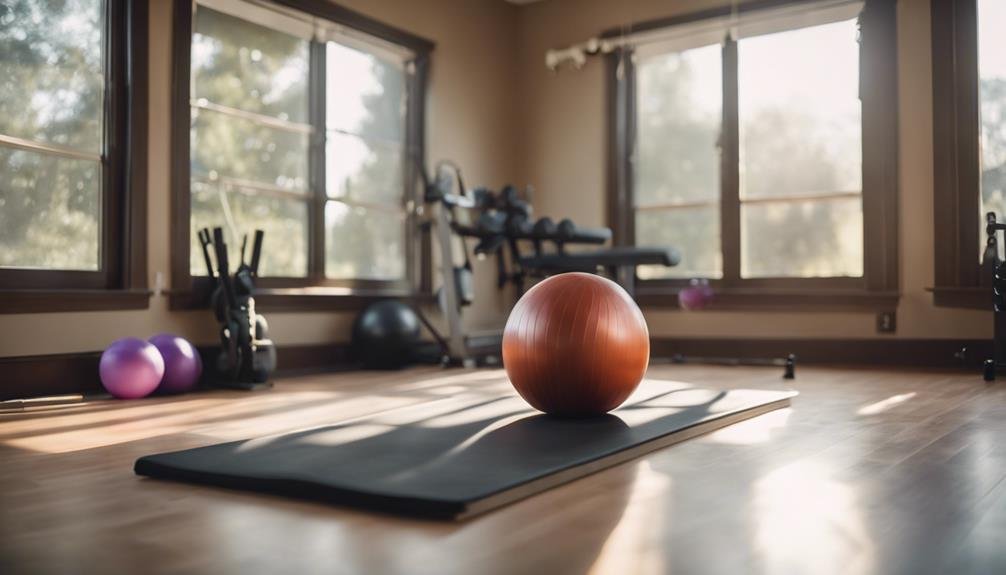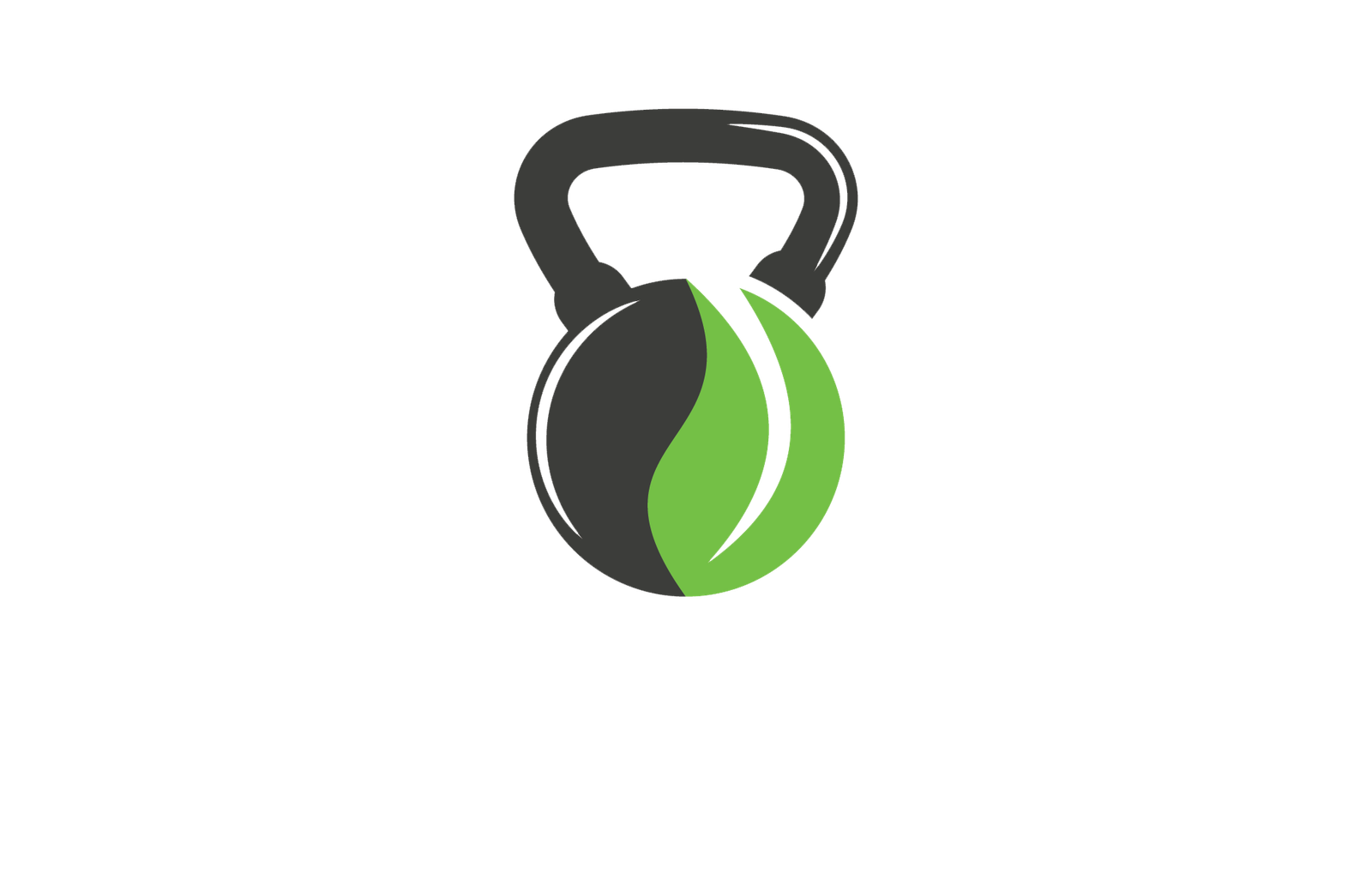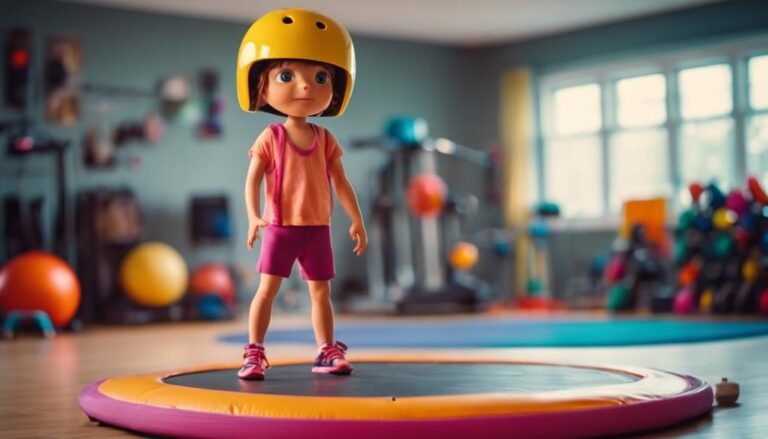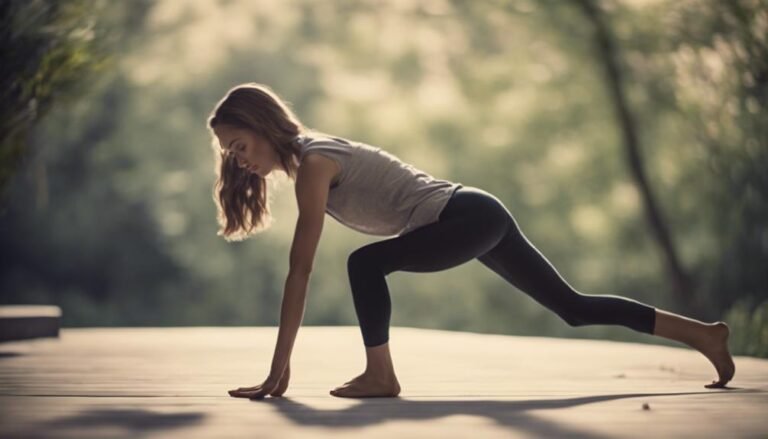Don't miss our holiday offer - 20% OFF!

Pilates Workouts: Strengthen and Tone at Home
Pilates workouts at home offer a powerful way to strengthen and tone your body, but what makes them so effective?
We're taking control of our fitness journey, and with Pilates, we can strengthen and tone our bodies from the comfort of our own homes. By combining physical and mental preparedness, we'll focus on mindfulness, respect our body's limitations, and reap the benefits of Pilates' holistic practice. At home, we can eliminate commuting time, work out efficiently, and track our progress at our own pace. With essential props, a well-planned schedule, and core-strengthening exercises, we'll be on our way to a stronger, more toned body. Now, let's get started and discover the transformative power of Pilates workouts at home!
Key Takeaways
- Practice Pilates at home to eliminate commuting time and energy, and fit workouts into your busy schedule.
- Invest in a good-quality Pilates mat and props like resistance bands or a Pilates ring to mimic Reformer movements.
- Create a home studio with a sprung floor, mirror, and organized storage for props and equipment to enhance your practice.
- Focus on core strengthening exercises that target the transverse abdominis muscle, essential for core alignment and pelvic stability.
- Establish a consistent Pilates practice by crafting a workout schedule that suits your lifestyle and fitness goals.
Getting Started With Pilates
As we set out on our Pilates journey, we begin by understanding that getting started requires a combination of physical and mental preparedness. We need to be aware of our body's limitations and capabilities, and be willing to listen to our inner voice. We must recognize that Pilates is not just a physical exercise, but a holistic practice that combines body, mind, and spirit.
As we explore the world of Pilates, we should familiarize ourselves with its rich history. Developed by Joseph Pilates in the early 20th century, this method has evolved over the years to become a popular form of exercise. When attending a Pilates studio, we should observe basic studio etiquette, such as arriving on time, wearing comfortable clothing, and respecting the instructor's guidance. By doing so, we create a conducive environment for learning and growth. Remember, Pilates is a journey, not a competition. By being mindful of our bodies and respecting the practice, we set ourselves up for success and a lifelong path of wellness.
Benefits of Home Workouts
Practicing Pilates at home offers us the flexibility to weave workouts into our busy schedules, allowing us to prioritize our well-being without sacrificing precious time. By exercising from the comfort of our own homes, we can eliminate the need to commute to a studio, saving us time and energy. This convenience benefit is especially valuable for those with hectic schedules or conflicting commitments.
Moreover, home workouts enable us to be more time-efficient. We can squeeze in a quick 15-minute session during our lunch break or fit in a longer workout during the weekend. This flexibility allows us to make Pilates a consistent part of our routine, even on the busiest of days. With online tutorials and videos at our fingertips, we can access a wealth of Pilates resources from the comfort of our own homes. This convenience and time efficiency mean we can focus on what matters most – strengthening and toning our bodies, and enjoying the many benefits Pilates has to offer. By working out at home, we can take control of our fitness journey and make progress at our own pace.
Essential Equipment and Props
We typically need only a few essential props and a bit of floor space to get started with a Pilates workout at home. One of the most vital investments we can make is in a good-quality Pilates mat. A good mat provides the necessary grip and cushioning to support our joints and spine during exercises. This is key to choosing a mat that's specifically designed for Pilates, as they're usually thicker and more dense than yoga mats.
Another essential prop we'll need is a Reformer alternative. Since not everyone has access to a traditional Reformer machine, we can use alternatives like resistance bands or a Pilates ring to mimic the same movements. These props provide the necessary resistance to engage our core and target specific muscle groups. We can also use small props like pillows or blocks to modify exercises and make them more accessible. By investing in these vital props, we can create a well-rounded and effective Pilates workout at home.
Building a Home Studio
Now that we've gathered our must-have props, let's carve out a dedicated space in our home to transform into a Pilates studio, tailored to our unique needs and fitness goals. This space will be our sanctuary, where we can focus on our practice, free from distractions.
When designing our studio, we'll consider the following essential elements:
- Natural Light: Position our studio near a window to capitalize on natural light, boosting our mood and energy.
- Flooring: Install a sprung floor or use a high-quality exercise mat to provide cushioning and support for our joints.
- Mirrors: Hang a mirror to confirm proper alignment and form, helping us refine our technique.
- Storage: Incorporate shelves or cabinets to keep our props and equipment organized and within reach.
- Calming Colors: Choose soothing colors for the walls, such as serene blues or calming greens, to create a peaceful atmosphere.
Core Strengthening Exercises
By targeting our core muscles, we'll improve our overall stability, balance, and posture, while also enhancing our athletic performance and reducing our risk of injury. A strong core is the foundation of a healthy body, and Pilates is an excellent way to achieve it. We'll focus on exercises that engage our transverse abdominis muscle, the deepest abdominal muscle that wraps around our spine and pelvis. This muscle is essential for maintaining good core alignment and pelvic stability.
To start, we'll perform exercises that challenge our core stability, such as the hundred, teaser, and side bends. These exercises will help us develop a strong, stable core that will improve our overall athletic performance. We'll also incorporate exercises that target our obliques, such as Russian twists and leg raises, to further enhance our core strength. As we progress, we'll increase the intensity by adding dynamic movements and props like resistance bands or a Pilates ball. With consistent practice, we'll develop a strong, stable core that will benefit our overall health and well-being.
Improving Flexibility and Mobility
Expanding our range of motion through Pilates exercises can greatly enhance our flexibility and mobility, allowing us to move more efficiently and effectively in our daily lives. By incorporating Pilates into our workout routine, we can improve our flexibility and mobility, making everyday activities easier and reducing our risk of injury.
Here are some key benefits of Pilates exercises for flexibility and mobility:
- Debunking Mobility Myths: Pilates helps us understand that mobility isn't just about being flexible, but about having control and strength in our movements.
- Improved Flexibility Fundamentals: Pilates exercises target our core, hips, and legs, increasing our range of motion and reducing stiffness.
- Enhanced posture and body awareness, allowing us to move with more confidence and poise.
- Reduced muscle tension and improved circulation, helping to alleviate pain and discomfort.
- Improved athletic performance and reduced risk of injury, making it an excellent addition to any workout routine.
Toning Your Upper Body
As we focus on toning our upper body, we're excited to explore exercises that will strengthen and sculpt our chest, shoulders, arms, and back. We'll start with movements that target our chest and shoulder tones, before moving on to arm circles and lifts that will have us feeling confident and strong. By incorporating these exercises into our Pilates routine, we'll be amazed at the definition and strength we can achieve in our upper body.
Chest and Shoulder Tones
We'll start toning our upper body by targeting the chest and shoulder muscles, which are essential for good posture, balance, and overall physical fitness. By incorporating Pilates exercises into our routine, we can improve our overall physique and even alleviate back pain.
Here are some key exercises to focus on for a stronger, toner upper body:
- Chest Expansion: Lie on your back with your knees bent and feet flat on the mat. Place your hands behind your head for support, not to pull your head up. Inhale, then exhale as you lift your shoulders off the mat, squeezing your chest muscles.
- Shoulder Alignment: Stand or sit with your arms at your sides. Engage your core and imagine a string pulling your head up towards the ceiling. Feel the alignment of your shoulders and chest, and maintain this posture as you move through your day.
- Practice shoulder rolls to loosen and relax your shoulder muscles.
- Use light weights or resistance bands to target your shoulder muscles.
- Incorporate chest stretches into your daily routine to improve flexibility and range of motion.
Arm Circles and Lifts
Now that we've established a strong foundation in our chest and shoulder muscles, let's move on to toning our arms with targeted exercises that will leave us feeling confident and powerful. Arm circles and lifts are essential for building arm flexibility and shoulder stability, which are vital for everyday activities and athletic performance.
To begin, hold your arms straight out to the sides at shoulder height. Make small circles with your hands for 10-15 reps in both clockwise and counterclockwise directions. This exercise will help increase arm flexibility and reduce stiffness. Next, lift your arms up and down, keeping them straight, for 10-15 reps. This will engage your shoulder muscles, improving stability and strength.
Remember to keep your shoulders down and away from your ears, and avoid scrunching up towards your neck. As we continue to tone our arms, we'll start to notice improvements in our posture and overall upper body strength. Let's keep moving and get those arms toned!
Back and Tricep Strength
Let's target our back and triceps with exercises that will sculpt a strong, toned upper body, allowing us to take on daily tasks and athletic pursuits with confidence. A strong back and triceps are essential for good posture, balance, and overall athletic performance. Weakness in these areas can lead to muscle imbalance, putting us at risk for injury.
Here are some Pilates exercises to help us achieve a strong and toned upper body:
- Lat Pull: Targets the latissimus dorsi muscles in our back, improving posture and reducing the risk of injury.
- Tricep Dips: Strengthens the triceps, helping us to extend our elbows and perform daily activities with ease.
- Scapular Squeezes: Engages the muscles between our shoulder blades, improving our posture and reducing muscle tension.
- Arm Circles: Targets the muscles in our upper back, improving our posture and reducing the risk of injury.
- Superman: Strengthens the muscles in our lower back, improving our posture and reducing the risk of lower back pain.
Lower Body Workout Routine
As we focus on our lower body, we're excited to explore exercises that will tone our legs, strengthen our glutes, and give us stronger calves. We'll work on achieving long, lean muscles that will improve our overall posture and balance. By incorporating targeted Pilates moves into our routine, we'll be taking the first step towards a stronger, more confident us.
Tone Your Legs
We'll start by targeting our hamstrings, quadriceps, and glutes with a series of exercises that will have our legs looking toned and feeling strong in no time. To achieve this, we'll focus on exercises that address muscle imbalance, which can lead to poor posture, injury, or chronic pain. One effective exercise is Leg Swings, which targets the hamstrings and glutes. Here are some additional exercises to tone our legs:
- Leg Raises: Lie on your back with your arms extended overhead, then lift one leg 6-8 inches off the mat, holding for a few seconds before lowering. Repeat on the other side.
- Side Kicks: Lie on your side with your feet touching, then lift your top leg away from your bottom leg, keeping it straight. Hold for a few seconds before lowering. Repeat on the other side.
- Wall Sits: Stand with your back against a wall, then slide down into a seated position, keeping your knees bent at a 90-degree angle. Hold for 30 seconds to engage your quadriceps.
- Calf Raises: Stand on the edge of a stair or step, then raise up onto your tiptoes, holding for a few seconds before lowering.
- Ankle Circles: Sit on the floor with your legs straight out in front of you, then lift one foot off the ground and draw small circles with your ankle, first clockwise and then counterclockwise. Repeat on the other side.
Glute Strengthening Moves
Now that we've toned our legs, we're ready to fire up our glutes with a series of targeted exercises that will lift, shape, and strengthen our backside. Our glutes are the largest muscle group in our body, and strong glutes can improve our posture, balance, and overall athletic performance. Let's get started with some effective Pilates moves that will engage our glutes and leave us feeling empowered and confident.
First up, we have glute bridges. Lie on your back with your knees bent and feet flat on the mat. Slowly lift your hips up towards the ceiling, squeezing your glutes at the top, and then lower back down. Aim for 3 sets of 10 reps. Next, we'll move on to hip lifts. Lie on your side with your feet stacked and lift your top knee up towards the ceiling. Hold for a second, then lower back down. Do 3 sets of 10 reps on each side. These exercises will have your glutes firing on all cylinders in no time!
Stronger Calves Ahead
By targeting our calf muscles with a combination of strengthening exercises and stretches, we can improve our overall lower body strength and agility. As we explore the world of calf anatomy, we'll discover that strong calf muscles are essential for proper foot mechanics and overall lower body function.
To get started, let's focus on these five key exercises to strengthen and tone our calf muscles:
- Seated Calf Raise: Targets the gastrocnemius muscle, helping to improve ankle mobility and strength.
- Calf Raises on a Step: Engages the soleus muscle, essential for balance and stability.
- Toe Taps: Targets the tibialis anterior muscle, vital for ankle stability and preventing injuries.
- Single-Leg Balance: Challenges our balance and strength, improving overall lower body function.
- Wall Push-Ups with Calf Raise: A compound exercise that targets multiple muscle groups, including the calf muscles.
Pelvic Floor and Core Connection
As we engage in Pilates exercises, our pelvic floor and core muscles work in tandem, creating a powerful synergy that enhances our overall stability, balance, and movement patterns. This harmonious connection is essential, as it allows us to move with efficiency and control. When we focus on pelvic alignment, we're able to engage our core muscles more effectively, which in turn supports our entire body. By maintaining a neutral pelvis, we create a strong foundation that enables us to move with precision and power.
As we strengthen our core, we're not just targeting our abs, but also our pelvic floor muscles. This core harmony allows us to generate force, stability, and control in our movements. By integrating our pelvic floor and core, we can improve our posture, reduce our risk of injury, and enhance our overall athletic performance. By incorporating Pilates exercises that focus on pelvic floor and core connection, we can experience a significant improvement in our overall physical fitness and wellbeing. By working together, our pelvic floor and core muscles can help us achieve a stronger, more balanced, and more efficient body.
Breathing and Body Awareness
As we move forward in our Pilates journey, we're going to focus on the essential connection between our breath and body awareness. We'll explore how mindful breathing enhances our physical movements, allowing us to tap into our inner strength and control. By cultivating this awareness, we'll be able to move with greater precision and precision, accessing the full potential of our Pilates practice.
Core Connection Essential
We begin to build a strong foundation for our Pilates practice by cultivating a deep connection with our core, which starts with developing awareness of our breath and body position. This connection is essential for achieving core stability, which is the foundation of a strong and efficient Pilates practice. By focusing on our breath and body position, we can engage our core muscles more effectively, leading to improved posture, balance, and overall physical awareness.
Here are some key elements to focus on as we cultivate our core connection:
- Breath awareness: Pay attention to your breath, feeling the rise and fall of your chest or belly as you inhale and exhale.
- Body position: Be mindful of your posture, keeping your shoulders relaxed and your spine long.
- Core engagement: Engage your transverse abdominis muscle by drawing your belly button towards your spine.
- Pelvic floor connection: Connect with your pelvic floor muscles, feeling a sense of lift and support in your pelvis.
- Mindful engagement: Focus on the sensations in your body, allowing yourself to fully engage with your core and surrounding muscles.
Mindful Movement Begins
With our core connection established, we're ready to integrate mindful breathing and body awareness into our movements, allowing us to cultivate a more intentional and powerful Pilates practice. As we move, we'll focus on mindful breathing, synchronizing our inhales and exhales with each exercise. This conscious breathing helps us stay present, relax, and engage our core more effectively. We'll also tune into our body awareness, paying attention to the sensations in our muscles, joints, and bones. This increased body awareness enables us to make subtle adjustments, refine our movements, and prevent injuries.
As we move through our Pilates routine, we'll incorporate conscious walking, paying attention to the way our feet touch the ground, the movement of our hips, and the alignment of our spine. This mindful approach helps us develop better posture, balance, and overall physical awareness. By combining mindful breathing and body awareness, we'll experience a more holistic, efficient, and effective workout. We'll move with intention, precision, and control, getting the most out of our Pilates practice.
Creating a Workout Schedule
Establishing a consistent Pilates practice requires crafting a workout schedule that suits our lifestyle and fitness goals. As we embark on this journey, it's essential to create a schedule that works for us, not against us. Morning routines can be an excellent way to start, setting a positive tone for the day ahead. However, we need to be realistic about our commitments and avoid scheduling conflicts that might hinder our progress.
To ensure we stick to our Pilates practice, let's consider the following:
- Set specific, achievable goals for each workout session
- Choose a consistent time of day that works for us, and try to avoid scheduling conflicts
- Start with manageable sessions (20-30 minutes) and gradually increase duration as we build endurance
- Incorporate rest days to allow our bodies to recover and rebuild
- Make adjustments as needed – life can be unpredictable, and it's essential to be flexible with our schedule
Modifying Exercises for Beginners
As Pilates newcomers, let's focus on modifying exercises to suit our fitness levels, ensuring a safe and effective progression into this low-impact, body-toning practice. We'll adopt Beginner Modifications that honor the Pilates Principles, respecting our bodies' limitations while still reaping the benefits of this incredible method.
By scaling back the intensity and complexity of exercises, we'll build confidence and strength gradually. For instance, we can reduce the range of motion, slow down our pace, or use props like blocks, straps, or a wall for support. This allows us to focus on proper alignment, engagement of core muscles, and controlled movements – the very essence of Pilates.
As we progress, we can gradually increase the challenge by adding more repetitions, sets, or weight. By listening to our bodies and honoring their limitations, we'll set ourselves up for success, avoiding frustration and potential injury. By incorporating these modifications, we'll create a strong foundation, paving the way for a lifelong practice that yields remarkable results.
Common Mistakes to Avoid
We're bound to encounter common pitfalls when starting a new exercise routine, and Pilates is no exception – recognizing and sidestepping these mistakes is essential to getting the most out of our workouts. As beginners, we're excited to jump into, but it's vital to avoid common mistakes that can hinder our progress and even lead to injuries.
These common mistakes to watch out for are:
- Overexertion Risks: pushing ourselves too hard, too fast, which can lead to fatigue, soreness, and even injuries.
- Failing to listen to our bodies, ignoring pain or discomfort, and not taking regular breaks.
- Inconsistent Form, which can put unnecessary strain on our muscles and joints.
- Rushing through exercises, sacrificing proper form for speed.
- Not warming up or cooling down, increasing the risk of injury and reducing the effectiveness of our workouts.
Tracking Progress and Staying Motivated
Let's explore the nitty-gritty of tracking our progress and staying motivated, where keeping tabs on our successes and setbacks helps us pinpoint areas for improvement and fuels our enthusiasm to push forward. We've worked hard to establish a consistent Pilates practice, and now it's time to monitor our progress and celebrate our achievements. By setting specific, measurable, and attainable goals, we can focus our efforts and stay motivated. We can track our progress by taking progress photos, measurements, or simply noting how we feel. Reward systems are also key – when we reach a milestone, we can treat ourselves to a massage or a new workout outfit. By acknowledging our successes and setbacks, we can refine our practice, making adjustments as needed. Remember, staying motivated is a journey, not a destination. Let's keep pushing forward, and celebrate the small victories along the way!
Frequently Asked Questions
Can I Do Pilates if I Have a Pre-Existing Injury or Condition?
"We can modify Pilates exercises to accommodate chronic pain and pre-existing injuries, focusing on injury prevention and gentle movements to promote healing and strengthen our bodies, not exacerbate conditions."
How Often Should I Practice Pilates to See Noticeable Results?
We find that practicing Pilates 2-3 times a week yields noticeable results; consistency matters, so we aim to make it a habit. To progress, we incorporate progressive overload, gradually increasing intensity to challenge ourselves.
Can I Modify Pilates Exercises to Accommodate My Body Type?
"As we navigate the fitness journey, we're like master gardeners, pruning and adapting exercises to suit our unique body types. We make posture adjustments, tweaking and tailoring Pilates moves to harmonize with our individual frames, ensuring a stronger, more balanced us."
Are There Any Pilates Exercises Specifically for Weight Loss?
"We're excited to share that yes, there are Pilates exercises specifically designed for weight loss! Focus on fat-burning moves that target our core, like plank variations and teaser exercises, to boost metabolism and burn calories efficiently."
Can I Combine Pilates With Other Exercise Routines for Better Results?
"We absolutely can combine Pilates with other exercise routines for better results! In fact, cross-training and hybrid workouts can enhance our overall fitness journey, offering a more well-rounded approach to achieving our goals."
Conclusion
As we wrap up our Pilates journey, it's no coincidence that our bodies are stronger, leaner, and more toned. We've transformed our living rooms into studios, invested in essential props, and mastered core-strengthening exercises. We've created schedules, avoided common mistakes, and tracked our progress. As we look in the mirror, we're reminded that the most powerful prop is our own dedication and discipline. By sticking to our at-home Pilates routine, we've coincidentally discovered a stronger, healthier, and happier us.



